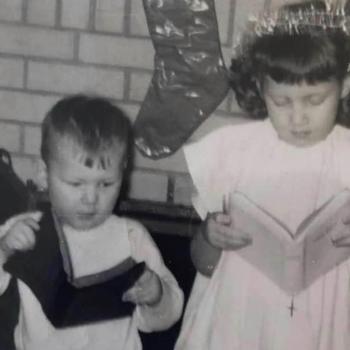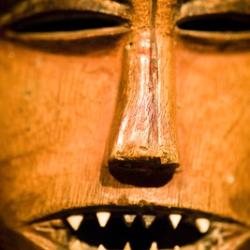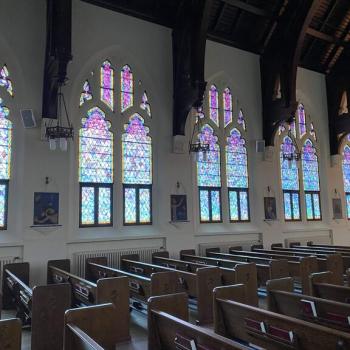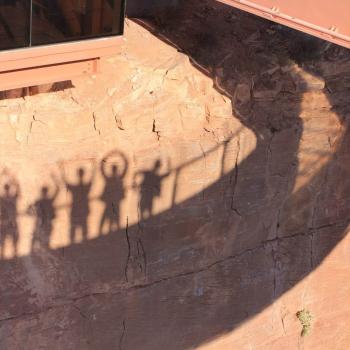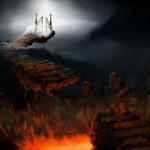In “A Tale of Two He-Goats Pt. 1,” I provided the beginning of a homily that sought to unpack the relevance of Leviticus 16:7-10 for today’s orthodox Christian. With the words that follow, I will conclude that project by describing exactly what the goat ritual of chapter sixteen teaches us about ourselves, as well as our Lord, Jesus Christ.

For those of you who missed part one, be sure to go back and read that post. There you will find a brief overview of the project, and learn about the ways in which the scapegoat and its sacrificial counterpart were significant for the inhabitants of ancient Israel.
Now, before I begin, here is the passage from Leviticus once again:
“He shall then take the two goats and present them before the Lord at the doorway of the tent of meeting. Aaron shall cast lots for the two goats, one lot for the Lord and the other lot for the scapegoat. Then Aaron shall offer the goat on which the lot for the Lord fell, and make it a sin offering. But the goat on which the lot for the scapegoat fell shall be presented alive before the Lord, to make atonement upon it, to send it into the wilderness as the scapegoat.” (Lev. 16:7-10)
What the Goats Teach Us About Ourselves
In Matthew chapter 27, we read the following:
“Not everyone who says to Me, ‘Lord, Lord,’ will enter the kingdom of heaven, but the one who does the will of My Father who is in heaven will enter. Many will say to Me on that day, ‘Lord, Lord, did we not prophesy in Your name, and in Your name cast out demons, and in Your name perform many miracles?’ And then I will declare to them, ‘I never knew you; leave Me, you who practice lawlessness.’ (Matt. 27:21-23)
Not all who outwardly profess faith are of the Lord’s fold. This may seem like a strange lesson to draw from a goat ritual, but I believe that the ritual can, in fact, be viewed as symbolic of this Biblical truth. Earlier we learned that Aaron brought both of the male goats before the Lord “at the doorway of the tent of meeting,” but one was a sacrifice to God, and the other was driven to the barren wilderness carrying the weight of Israel’s sins upon its back.
In a similar manner, many claim to be Christian; many assert that they stand before God as a willing sacrifice, dying to self each day in order to live for Christ. But some of these do not have true saving faith. Like the scapegoat, those who are only outwardly Christian will be driven to a desolate place when their time on Earth is concluded; they will bear their many sins alone and be cast into that place which is most desolate—desolate of God, Christ, and all that is good.
We see this depicted in the story of the Rich Man and Lazarus (Luke 16:19-31). The rich man, who received his only pleasure before death was sent to the realm of torment, a place desolate of joy and God. Lazarus, on the other hand, was comforted in the arms of Abraham in the afterlife. Lazarus stored his treasures in heaven and heeded God’s call for repentance; he was not cast into the spiritual wilderness like the Rich man who was the bearer of his own sins.
What the Goats Teach Us About Christ
The two goats that bore Israel’s sin on the Day of Atonement also prefigured the two natures that are united in Jesus. In the Nicene Creed, we recite the following:
“I believe in one Lord Jesus Christ, the Only Begotten Son of God, born of the Father before all ages. God from God, Light from Light, true God from true God, begotten, not made, consubstantial with the Father; through him all things were made. For us men and for our salvation he came down from heaven, and by the Holy Spirit was incarnate of the Virgin Mary, and became man. For our sake he was crucified under Pontius Pilate, he suffered death and was buried, and rose again on the third day in accordance with the Scriptures.” And so on…
As Christians we confess, and rightly so, that Jesus is both fully man and fully God. Thus, He has two natures: a human nature and a divine nature. In the goat that was sacrificed as a sin-offering on the Day of Atonement, we see the humanity of Christ, that aspect of our Lord that was susceptible to bodily harm and suffering. Although Jesus is God, His body was bruised and beaten by Roman soldiers, His brow pierced with a thorny crown, and His broken body hung upon a cross until He gave up His spirit to the Father. Christ in His human nature endured incomparable suffering and was slain like the goat on which the Lord’s lot fell.
As I have mentioned, Christ was the perfect sin offering, extinguishing the need for further sacrifice and atonement. But Jesus’ divine nature, even during the crucifixion, never suffered. Like the goat in Leviticus that was sent away from the children of Israel, Christ bore our sins while His divinity remained unscathed and unchanged. Truly, we affirm that Christ is fully God and God does not change. The book of James says: “Every good gift and every perfect gift is from above, coming down from the Father of lights, with whom there is no variation or shadow due to change.” (Jas 1:17)
God the Father, and God the Son are one Lord and they share a single divine nature which does not suffer, because suffering would imply physical or emotional change, and such circumstances cannot befall our God, who once again, is changeless.
The two goats of Leviticus 16 represent a single ritual that effected atonement for the sins of the House of Israel. Yet one goat was brought before the Lord at the doorway of the tent of meeting to be slaughtered, while the other to depart with neither cut nor scrape. At Calvary, Christ enacted final atonement, not just for Israel, but for all of humanity; He was crucified as a perfect man and remained whole and unchanged as the God of all creation. Just as there is unity in the diversity of the ritual of the goats, so there is unity in the two natures that make up Jesus, our messiah.
He Who Was Rejected By Men
Although much has already been said about how the goats of Leviticus 16 symbolize Christ, there is yet another lesson that they teach us about the Prince of Peace. The scapegoat, the animal that was to be sent into the wilderness prefigured Jesus in that Christ was rejected by those whom He came to save. The goat, after being afflicted by the sins of the nation was not accepted and enjoyed as other similar animals would have been at the time. Instead, it was cast out from among the Israelites to carry their sins alone to a desolate place.
Jesus also came to bear the transgressions of Israel and all nations, but was not immediately regarded as the savior; when Christ came, at first, not even His brothers believed in Him. Over time, however, many came to believe; many witnessed Jesus’ miracles and had faith that He was the Son of God. Still many others, even at the end of His ministry, denied that He was the Christ. Those who refused to see Jesus as the fulfillment of the Bible’s prophesies concerning the Messiah actually helped bring about the fulfillment of Psalm 118; for the stone that the builders rejected was none other than the cornerstone.
Christ bore the sins of the people like the scapegoat, but He, unlike the goat, was not recognized as doing so; He was despised and rejected by men, a man of sorrows and acquainted with grief; and as one from whom men hide their faces he was despised, and we esteemed him not. (Isaiah 53:3)
The Richness of the He-Goats
In conclusion, what we read in Leviticus 16:7-10 is far from being irrelevant to the modern Christian. In fact, it sums up much of Scripture in just a few sentences. In this passage, we receive valuable information concerning ourselves as fallible creatures, and God to whom we owe our complete devotion; it exposes our need for atonement, teaches us about Christ’s two natures, pleads that we have true saving faith, and shows us that only an immaculate, immortal sacrifice can quench God’s righteous anger. Truly, in the description of the goat ritual we see a summation of the Gospel, the good news that encapsulates the drama of all existence:
All have fallen short of the Glory of God because we have inherited the sinful nature established by our first parents, Adam and Eve. But, as we have learned in these two posts, sin cannot go unpunished, for God is completely just. Therefore the Son of God became incarnate and lived a perfect life so that He could give His life as a ransom for many. Christ died in our stead, but did not remain dead; He was raised to life on the third day and afterward ascended to the right hand of the Father. From there He will come to judge the living and the dead.
Do you believe this? Whoever is to repent of their sins and have faith in Christ Jesus, this person shall inherit eternal life. But whoever denies Christ to rely on their own goodness and righteousness will receive nothing of the sort; they will be under the wrath of God, eternally separate from Him, the Lord of All.
Brothers and sisters trust in Him, pray to Him, ask for forgiveness, and humble yourselves before the only one who is truly Holy.



